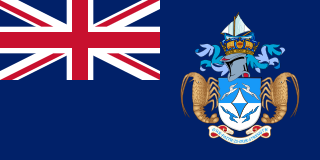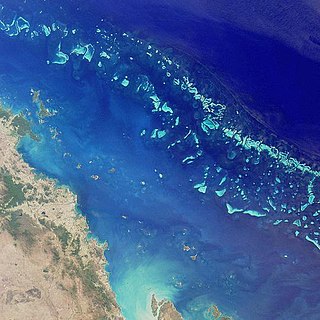
Organisms of many species are specialized into male and female varieties, each known as a sex. Sexual reproduction involves the combining and mixing of genetic traits: specialized cells known as gametes combine to form offspring that inherit traits from each parent. The gametes produced by an organism define its sex: males produce small gametes while females produce large gametes. Individual organisms which produce both male and female gametes are termed hermaphroditic. Gametes can be identical in form and function, but, in many cases, an asymmetry has evolved such that two different types of gametes (heterogametes) exist.

Tristan da Cunha, colloquially Tristan, is a remote group of volcanic islands in the south Atlantic Ocean. It is the most remote inhabited archipelago in the world, lying approximately 1,732 miles (2,787 km) off the coast of Cape Town in South Africa, 1,514 miles (2,437 km) from Saint Helena and 2,487 miles (4,002 km) off the coast of the Falkland Islands. These distances equate respectively to 1505, 1316 and 2161 nautical miles.

A banana is an elongated, edible fruit – botanically a berry – produced by several kinds of large herbaceous flowering plants in the genus Musa. In some countries, bananas used for cooking may be called "plantains", distinguishing them from dessert bananas. The fruit is variable in size, color, and firmness, but is usually elongated and curved, with soft flesh rich in starch covered with a rind, which may be green, yellow, red, purple, or brown when ripe. The fruits grow in clusters hanging from the top of the plant. Almost all modern edible seedless (parthenocarp) bananas come from two wild species – Musa acuminata and Musa balbisiana. The scientific names of most cultivated bananas are Musa acuminata, Musa balbisiana, and Musa × paradisiaca for the hybrid Musa acuminata × M. balbisiana, depending on their genomic constitution. The old scientific name for this hybrid, Musa sapientum, is no longer used.

The Amazon rainforest, alternatively, the Amazon jungle or Amazonia, is a moist broadleaf tropical rainforest in the Amazon biome that covers most of the Amazon basin of South America. This basin encompasses 7,000,000 km2 (2,700,000 sq mi), of which 5,500,000 km2 (2,100,000 sq mi) are covered by the rainforest. This region includes territory belonging to nine nations and 3,344 formally acknowledged indigenous territories.

The Great Barrier Reef is the world's largest coral reef system composed of over 2,900 individual reefs and 900 islands stretching for over 2,300 kilometres (1,400 mi) over an area of approximately 344,400 square kilometres (133,000 sq mi). The reef is located in the Coral Sea, off the coast of Queensland, Australia. The Great Barrier Reef can be seen from outer space and is the world's biggest single structure made by living organisms. This reef structure is composed of and built by billions of tiny organisms, known as coral polyps. It supports a wide diversity of life and was selected as a World Heritage Site in 1981. CNN labelled it one of the seven natural wonders of the world. The Queensland National Trust named it a state icon of Queensland.

Sir David Frederick Attenborough is an English broadcaster and natural historian. He is best known for writing and presenting, in conjunction with the BBC Natural History Unit, the nine natural history documentary series forming the Life collection that together constitute a comprehensive survey of animal and plant life on Earth. He is a former senior manager at the BBC, having served as controller of BBC Two and director of programming for BBC Television in the 1960s and 1970s. He is the only person to have won BAFTAs for programmes in each of black and white, colour, HD, 3D and 4K. In 2018 and 2019, he received Primetime Emmy Awards for Outstanding Narrator. He considers his 2020 documentary film, David Attenborough: A Life On Our Planet, his personal witness statement of his life and the future.

The International Union for Conservation of Nature (IUCN) Red List of Threatened Species, founded in 1964, is the world's most comprehensive inventory of the global conservation status of biological species. It uses a set of criteria to evaluate the extinction risk of thousands of species and subspecies. These criteria are relevant to all species and all regions of the world. With its strong scientific base, the IUCN Red List is recognized as the most authoritative guide to the status of biological diversity. A series of Regional Red Lists are produced by countries or organizations, which assess the risk of extinction to species within a political management unit.

Sturgeon is the common name for the 27 species of fish belonging to the family Acipenseridae. The earliest sturgeon fossils date to the Late Cretaceous, and are descended from other, earlier acipenseriform fish who date back to the Triassic period some 245 to 208 million years ago. The family is grouped into four genera: Acipenser, Huso, Scaphirhynchus and Pseudoscaphirhynchus. Four species may now be extinct. Two closely related species, Polyodon spathula and Psephurus gladius are of the same order, Acipenseriformes, but are in the family Polyodontidae and are not considered to be "true" sturgeons. Both sturgeons and paddlefish have been referred to as "primitive fishes" because their morphological characteristics have remained relatively unchanged since the earliest fossil record. Sturgeons are native to subtropical, temperate and sub-Arctic rivers, lakes and coastlines of Eurasia and North America.

Skinks are lizards belonging to the family Scincidae, a family in the infraorder Scincomorpha. With more than 1,500 described species, the family Scincidae is one of the most diverse families of lizards.

Wikispecies is a wiki-based online project supported by the Wikimedia Foundation. Its aim is to create a comprehensive free content catalogue of all species; the project is directed at scientists, rather than at the general public. Jimmy Wales stated that editors are not required to fax in their degrees, but that submissions will have to pass muster with a technical audience. Wikispecies is available under the GNU Free Documentation License and CC BY-SA 3.0.

Pokémon is a series of video games developed by Game Freak and published by Nintendo and The Pokémon Company under the Pokémon media franchise. Created by Satoshi Tajiri with assistance from Ken Sugimori, the first games, Pocket Monsters Red and Green, released in 1996 in Japan for the Game Boy, and the main series of role-playing video games (RPGs), referred as the "core series" by their developers, have continued on each generation of Nintendo's handhelds. The most recently released core series games, Pokémon Sword and Shield, were released worldwide on the Nintendo Switch on November 15, 2019.

The Catalogue of Life is an online database that provides the most comprehensive and authoritative index of known species of animals, plants, fungi, and microorganisms. It was created in 2001 as a partnership between the global Species 2000 and the American Integrated Taxonomic Information System. The Catalogue interface is available in twelve languages and is used by research scientists, citizen scientists, educators, and policy makers. The Catalogue is also used by the Biodiversity Heritage Library, the Barcode of Life Data System, Encyclopedia of Life, and the Global Biodiversity Information Facility. The Catalogue currently compiles data from 168 peer-reviewed taxonomic databases, that are maintained by specialist institutions around the world. As of 2019, the Catalogue lists 1,837,565 of the world's 2.2m extant species known to taxonomists on the planet at present time.
Brasilotyphlus is a genus of caecilians in the family Siphonopidae. It was considered monotypic, containing only the species Brasilotyphlus braziliensis. However, two recently described species, Brasilotyphlus guarantanus and Brasilotyphlus dubium, have been placed in this same genus. Both species have only been recorded from Brazilian Amazonia. This genus has also been suggested as paraphyletic to Microcaecilia.
Luetkenotyphlus brasiliensis, the São Paulo caecilian, is a species of caecilian in the family Siphonopidae. It is found in Misiones Province in northern Argentina and northwards to São Paulo state in Brazil; it likely occurs in adjacent Paraguay.
Luetkenotyphlus insulanus, the insular caecilian, is a species of caecilian in the family Siphonopidae. It is endemic to the Ilhabela archipelago in Brazil. Its natural habitat is subtropical forest where it lives in the soil.
The Plant List is a list of botanical names of species of plants created by the Royal Botanic Gardens, Kew and the Missouri Botanical Garden and launched in 2010. It was intended to be a comprehensive record of all known names of plant species over time, and was produced in response to Target 1 of the 2002-2010 Global Strategy for Plant Conservation, to produce "An online flora of all known plants.” It has not been updated since 2013, and is superseded by World Flora Online.

The Siphonopidae are the family of common caecilians. They are found in Central and South America. Like other caecilians, they superficially resemble worms or snakes.

World Flora Online is an Internet-based compendium of the world’s plant species.













